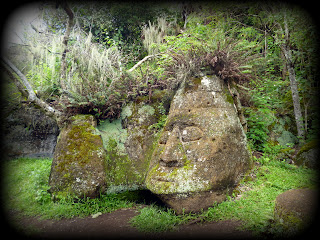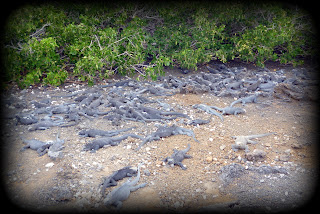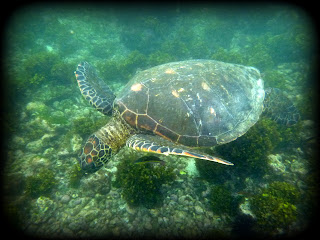We were up almost before the sun was. (But for sure before the sea lions were… *g*)
We grabbed the snorkel gear we had received from the hotel manager the night before, and walked some 15 minutes down to Concha de la Perla, the ideal snorkeling spot – especially at 6am in the morning, when there is absolutely no one else who doesn’t live there permanently; and that only includes sea lions, marine iguanas, sea turtles, crabs, some birds and a lot of fish.
Well – and those were our snorkeling companions. (Except for the sea turtles…) May I introduce again: Fish…
…fish…
…and more fish…
…as well as a sea lion, that came sooo close to play, that I was sincerely frightened it would attack me! But, turned out, that the more I turned around, the more I excited it to circle around me – in a speed one can hardly imagine! (The picture is taken without zoom! And yes, I do have a wide-angle camera!)
But well, obviously I was too slow for it after a while, and it didn’t speak my bubble-language. So it left and started looking for Sarina… ^^
Mr. Crab was there as well.
Oh, sorry, I forgot above to mention: Mr. Manta Ray was present as well.
After so much action I had to relax a little. But hey, take a closer look a the picture – I wasn’t the laziest creature on that wooden planks… ^^ (Guess which one it was?)
The solution: It was the marine iguana. Because, after I had lifted my weight off the ground again, Sarina and I stepped over it as if nothing would happen. That dude didn’t even bother to blink an eye! Sometimes it’s just impossible to maintain the recommended 3m minimum distance to those wild animals.
And it became even more impossible, when we wanted to pass the next animal – Mr. Sea Lion. For some unknown reason, it started to “attack” Sarina. Well, in my opinion, it just wanted to play, but you never know.
When it came after me, I stood my ground, and it understood who the master is (or the boring guy who's not in the playing mood, respectively. *g*).
So I stepped over it – and it started to chase Sarina again, another 10m down the path. *hahaha*At least I enjoyed the experience… *g* Honestly – would you guys think this cutie could do you any harm?
Anyway, we decided to leave some space between us and the sea lion for our early morning nap.
Finally we had earned our 5$-breakfast in our hotel (which was absolutely worth the money, fruit salad, croissants, toasts…), put our snorkel gear back and some sunscreen on instead, and walked back to the restaurant where we had eaten the night before.
The roads in Puerto Vilamil are amazing. Three reasons for that: Firstly, they are gravel roads, which are way more fun to cruise on on a bike, as I learned in my early childhood years. Secondly, there are hardly any cars or motorbikes to disturb the magical silence. And, last but not least, Puerto Vilamil features the coolest lampposts I have ever seen in my life so far! :)
Oh, and, Mum: There are tons of beautiful flowers along the way, wherever you go.
We set off to our bike tour. No biggie, you know. Just cruising along the beach…
…chasing marine iguanas from time to time…
…balancing our weight on those 2 wheels when some lazy animals wouldn’t move…
…gazing at some rather unspectacular lagoons along the way…
…which sometimes happened to be red…
…and parking our bike from time to time…
…to visit some marine iguanas nesting ground. (Someone wants to count all the animals to be detected?)
As you can see, it was a rather unspectacular ride, we only undertook to finally get barked at by a National Park guide for taking this picture:
I’m standing on “La Muralla de las Lagrimas”, built by some 300 prisoners who were brought here in the 18th century. Working conditions were tough. So tough, that those poor prisoners were promised freedom. Should they survive. Most of them didn’t. That’s why it got its name: Wall of Tears.
I also almost burst into tears: My bike had a puncture. So we had to pay some ridiculous 10$ to get a cab ride home. What a bugger.
But well, those sorrows were rapidly forgotten after some yummy lunch at our standard restaurant. And we needed the energy, as also the afternoon plan was already made: “Las Tintoreras” was waiting for us.
“Las Tintoreras” is a little islet some 2 mins from Isabela’s pier. We had to book a guide in order to get access granted to the islet, but that wasn’t a big problem, as our hotel manager, Julio, turned out to be a naturalist guide. 25$ per person had to be paid for an experience one will never forget.
“Las Tintoreras” is a breeding spot for marine iguanas. Not just a breeding spot – the breeding spot, I’d say. Hundreds, no, thousands of those dinosaur-like creatures are living on an islet not bigger than a soccer court. No matter, how vigilant we tried to stick to the path, one could hardly avoid stepping on an iguana or its nesting hole. Should you not believe me, well, try to count the iguanas in this picture.
Pretty easy, hmm? Well – it might be a bit more difficult here.
It is just stunning, to walk along those tiny pathways and feel like being part of the whole colony yourself. And Julio, our knowledgeable tour guide, enhanced the whole experience with loads of information on the iguanas, their breeding habits, other wildlife found on the islands as well as the history of this magical place. Here’s a little excursion into the past:
The Galapagos Islands, as we know them today, are pretty young. San Cristobal, the oldest island, is supposed to be around 3.5 million years old, whereas the younger islands, like Isabela and Fernandina, are still being formed (last volcanic eruption on Isabela in April 2009). The islands lie above a so-called Hot Spot on a tectonic plate called Nazca, which moves around 2.5 cm East per year. That is why older islands are further to the East, whereas the younger islands are formed in the West.
Charles Darwin assumed that 3.5 million years are not enough time to bring evolution as far as he observed it when he came to visit the islands in 1835, some 300 years after they had been discovered by a Spanish bishop of Panama called Berlanga. Darwin was right: A lot of former Galapagos Islands have already sunk beneath the water’s surface to the East of San Cristobal, due to continuous erosion. And the same fate probably awaits every other islands of the archipelago… (The history since the discovery of Berlanga is covered pretty well in Wikipedia - and pretty interesting as well.)
Back to our story: After having seen enough marine iguanas for a lifetime, we embarked our little vessel again. But the trip wasn’t over: Way more wildlife had to be discovered. And as we had seen enough terrestrial animals now, it was time to scratch a little at the surface – and maybe have a look underneath the surface. The ocean’s surface.
The last thing we saw before jumping over board with our snorkel equipment were penguins. Yes, correct, penguins. At the equator. Galapagos penguins. Cute, ey?
Still, we had forgotten them some mere 10 minutes later – that is when Julio spotted the first sea turtle for us.
And there were more. I think, we saw around five or six of these beauty- and peaceful reptiles. Sometimes the current was that strong that It was hard to move away in order not to touch them! (Again – no zoom used for this picture!)
But there were more animals down there. The fish and the colorful corals almost became irrelevant extras…
…as I saw my very first “Tintorera”, a white-tip reef shark.
Julio went cave-diving to find some more for us…
…and was successful!
Only after I had dived down into that cave, found some more reef sharks and finally embarked the boat again, I was told that these fellows can be dangerous at times… ^^
But by then, I was already too tired to worry about anything. The sun was setting and we headed back to Sula Sula – for one last night on the most paradisiacal islands in paradise.















































